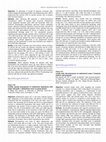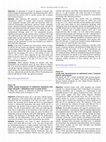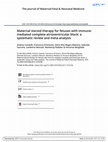Papers by Mackenzy Radolec
Gynecologic Oncology, Aug 1, 2022

Cancer Research, Jun 15, 2022
Background: Over a decade ago, the Cancer Genome Atlas (TCGA) provided the initial genomic charac... more Background: Over a decade ago, the Cancer Genome Atlas (TCGA) provided the initial genomic characterization of ovarian cancer with targeted exome capture and sequencing. Unlike other TCGA analysis, they were unable to identify prognostic mutational profiles outside of BRCA status. There has been limited characterization of the ovarian cancer genomic profile since. Our objective presented here was to perform whole exome and whole transcriptome analysis of 241 ovarian cancer samples and compare to the TCGA dataset. This is the first phase of a muti-step ongoing analysis wherein we will input and correlate the complete genomic profile, complete patient outcome data, and immunohistochemical staining into a multi-omic artificial intelligence (AI) machine learning model with the aim of improved individualized outcome prediction. Methods: Tumor samples from 2000-2016 were obtained at time of surgery under approved University of Pittsburgh approved IRB consent. Whole exome and whole transcriptome sequencing were performed in collaboration with Helomics Corporation. Sequencing analysis was compared to TCGA data. Results: 241 patient samples underwent sequencing analysis. Similar to TCGA, most mutations were missense. I am having a difficulty interpreting the magee vs tcga comparison graphs, how to discuss the TP53 and BRCA comparison without using the lollipop charts and highlighting the rna-seq data into written form. Please add. Conclusions: We present our findings of one of the largest molecular characterizations of ovarian cancer. Similar to the TCGA, there is noted heterogeneity to the genomic profile of ovarian cancer. Multi-omic AI outcome modeling has the potential to overcome the gap defining prognostic sub-groups so that we can tailor therapies to the individual Citation Format: Brian Orr, Robert P. Edwards, Mackenzy Radolec. Multi-omic artificial intelligence outcome modeling of ovarian cancer, phase I: Whole exome and whole transcriptome data [abstract]. In: Proceedings of the American Association for Cancer Research Annual Meeting 2022; 2022 Apr 8-13. Philadelphia (PA): AACR; Cancer Res 2022;82(12_Suppl):Abstract nr 5789.
Gynecologic Oncology, Jun 1, 2022
Cancers, Dec 11, 2020
The overall five-year survival rate in epithelial ovarian cancer is 44% and has only marginally i... more The overall five-year survival rate in epithelial ovarian cancer is 44% and has only marginally improved in the past two decades. Despite an initial response to standard treatment consisting of chemotherapy and surgical removal of tumor, the lesions invariably recur, and patients ultimately die of chemotherapy resistant disease. New treatment modalities are needed in order to improve the prognosis of women diagnosed with ovarian cancer. One such modality is immunotherapy, which aims to boost the capacity of the patient's immune system to recognize and attack the tumor cells. We performed a retrospective study to identify some of the most promising immune therapies for epithelial ovarian cancer. Special emphasis was given to immuno-oncology clinical trials.

Gynecologic Oncology, Jun 1, 2019
Methods: After obtaining IRB approval, a multi-institutional retrospective cohort of women with r... more Methods: After obtaining IRB approval, a multi-institutional retrospective cohort of women with recurrent endometrial cancer diagnosed between April 1999 and November 2016 was collected. Demographic information, operative reports, pathology reports, adjuvant treatment regimens, recurrence data, and date of death were abstracted from the patients' charts. Women who met criteria for high intermediate-risk disease as defined by GOG 99 (endometrioid histology grade 2-3, N2/3 myometrial invasion, lymphovascular space invasion; patients need ≥1 risk factor (RF) if age N70, ≥2 RF if age 50-69, 3 RF if age b50) were included in the analysis. Kaplan-Meier survival analysis was used to compare PFS and OS by treatment type without adjustment. A Cox proportional hazards analysis was also performed to assess how treatment was related to OS and PFS after adjustment. Results: In the study, 63 patients met the inclusion criteria. Of these, 43 (68.2%) did not receive any adjuvant treatment and 20 (31.8%) received adjuvant therapy (radiation, chemotherapy, or a combination of both). Median PFS and OS were not statistically different between the two groups: PFS (16.9 vs. 18.8 months, p=0.87), OS (45.8 vs. 64.9, p=0.57). After adjusting for age, LVSI, grade, and depth of invasion, there was no difference in PFS (HR 1.51, 95% CI 0.65-3.53, p = 0.8072) or OS (HR 1.12, 95% CI 0.44-2.84, p=0.5702) between groups.

Cancer Research
Rationale: Most ovarian tumors show some level of infiltration by T lymphocytes, and increasing l... more Rationale: Most ovarian tumors show some level of infiltration by T lymphocytes, and increasing levels of tumor-infiltrating lymphocytes (TIL) correlate with improved outcomes. The field of cancer immunotherapy has rapidly evolved and made a significant impact on many tumor types, including gynecologic cancers. However, single agent immune therapies have not yet demonstrated significant clinical success in epithelial ovarian cancer (EOC). We hypothesize that a combination of intraperitoneal (IP) chemotherapy (cisplatin) with dual agent immunotherapy using intravenous (IV) pembrolizumab (anti-PD1) and IP rintatolimod (TLR-3 agonist) will help overcome immune suppressive mechanisms for improved tumor response by promoting increased T cell chemotaxis and cytolytic function. Methods: To test our hypothesis, we are running an investigator initiated, phase II, single arm, efficacy/safety trial (NCT03734692). Peritoneal fluid aspiration (IP wash) was performed in 13 patients at multiple ti...

Cancer Research
Background: Over a decade ago, the Cancer Genome Atlas (TCGA) provided the initial genomic charac... more Background: Over a decade ago, the Cancer Genome Atlas (TCGA) provided the initial genomic characterization of ovarian cancer with targeted exome capture and sequencing. Unlike other TCGA analysis, they were unable to identify prognostic mutational profiles outside of BRCA status. There has been limited characterization of the ovarian cancer genomic profile since. Our objective presented here was to perform whole exome and whole transcriptome analysis of 241 ovarian cancer samples and compare to the TCGA dataset. This is the first phase of a muti-step ongoing analysis wherein we will input and correlate the complete genomic profile, complete patient outcome data, and immunohistochemical staining into a multi-omic artificial intelligence (AI) machine learning model with the aim of improved individualized outcome prediction. Methods: Tumor samples from 2000-2016 were obtained at time of surgery under approved University of Pittsburgh approved IRB consent. Whole exome and whole transcr...

Gynecologic Oncology, 2019
Methods: After obtaining IRB approval, a multi-institutional retrospective cohort of women with r... more Methods: After obtaining IRB approval, a multi-institutional retrospective cohort of women with recurrent endometrial cancer diagnosed between April 1999 and November 2016 was collected. Demographic information, operative reports, pathology reports, adjuvant treatment regimens, recurrence data, and date of death were abstracted from the patients' charts. Women who met criteria for high intermediate-risk disease as defined by GOG 99 (endometrioid histology grade 2-3, N2/3 myometrial invasion, lymphovascular space invasion; patients need ≥1 risk factor (RF) if age N70, ≥2 RF if age 50-69, 3 RF if age b50) were included in the analysis. Kaplan-Meier survival analysis was used to compare PFS and OS by treatment type without adjustment. A Cox proportional hazards analysis was also performed to assess how treatment was related to OS and PFS after adjustment. Results: In the study, 63 patients met the inclusion criteria. Of these, 43 (68.2%) did not receive any adjuvant treatment and 20 (31.8%) received adjuvant therapy (radiation, chemotherapy, or a combination of both). Median PFS and OS were not statistically different between the two groups: PFS (16.9 vs. 18.8 months, p=0.87), OS (45.8 vs. 64.9, p=0.57). After adjusting for age, LVSI, grade, and depth of invasion, there was no difference in PFS (HR 1.51, 95% CI 0.65-3.53, p = 0.8072) or OS (HR 1.12, 95% CI 0.44-2.84, p=0.5702) between groups.

The journal of maternal-fetal & neonatal medicine : the official journal of the European Association of Perinatal Medicine, the Federation of Asia and Oceania Perinatal Societies, the International Society of Perinatal Obstetricians, Jan 17, 2017
To explore the effect of maternal fluorinated steroid therapy on fetuses affected by immune-media... more To explore the effect of maternal fluorinated steroid therapy on fetuses affected by immune-mediated complete atrio-ventricular block (CAVB) in utero. Pubmed, Embase, Cinahl and ClinicalTrials.gov databases were searched. Only studies reporting the outcome of fetuses with immune CAVB diagnosed on prenatal ultrasound without any cardiac malformations and treated with fluorinated steroids compared to those not treated were included. The primary outcome observed was the regression of CAVB; secondary outcomes were: need for pacemaker insertion overall mortality, defined as the occurrence of either intrauterine (IUD) or neonatal (NND) death, IUD, NND, termination of pregnancy (TOP). Furthermore, we assessed the occurrence of all outcomes in fetuses with compared to those without hydrops at diagnosis. Meta-analyses of proportions using random effect model and meta-analyses using individual data random-effect logistic regression were used to combine data. Eight studies (162 fetuses) were i...
Uploads
Papers by Mackenzy Radolec